From cats to owls: the animals of Felice Boselli, country painter
If we were to draw up a ranking of the most bizarre artist signatures, that of the Piacenza painter Felice Boselli (1650 - 1732) would certainly be at the top of the list. A constant and indeed almost ubiquitous presence, in Boselli’s paintings, is the cat: we find him sneaking around among baskets of fruit, we see him trying to grab a fish, or while he is intent on tasting a piece of meat he has already spotted. In Latin, the term used to describe the cat is felis: a word that recalls the name, also in Latin, of Felice Boselli, Felix. Many scholars have therefore been inclined to interpret as a kind of signature the presence of the cat in Felice Boselli’s paintings: we have no evidence to confirm this for us with certainty, but it is highly probable that the reason for this inordinate passion for small felines must be precisely the connection between the Latin name of the cat and that of the painter.
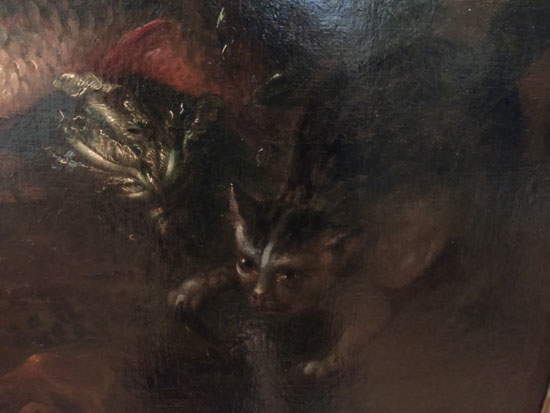 |
| Felice Boselli, Still Life with Fish, detail (ca. 1720; Piacenza, Musei Civici di Palazzo Farnese, Pinacoteca) |
Cats that, by the way, make particularly vivid (creating a bizarre ... contrast of terms) the still life genre, the one Felice Boselli practiced most often during his career: this peculiarity made him almost an Emilian Frans Snyders because, as Piacenza art historian Ferdinando Arisi had occasion to observe in several essays dedicated to the artist, Boselli’s painting, as well as Snyders’, introduces “action” elements into still life. Thus, if in Snyders we had characters carrying baskets of fruit, dogs sniffing food, or mischievous monkeys stealing it, in Boselli we have a multitude of kittens (but also other animals, as we shall see before long) visibly attracted to game, fish and, in general, to morsels easy to snatch from distracted people who have left their foodstuffs at the mercy of the pussycats.
And, of course, the cat is not lacking in the artist’sself-portrait either: the National Gallery in Parma has one in which the painter, now an old man in his late seventies (in fact, a date around 1720 has been proposed for the painting, when his colors became darker and the impasto coarser), portrays himself as he turns his gaze, with a certain pride, to us observers, without ceasing to dip his brush into the palette he holds in his left hand. Behind him, a painting with a still life, symbolizing the genre that, as anticipated, is the one prevalent in Felice Boselli’s production. And, from behind, peeps the usual cat, who rests his paws on the painter’s right shoulder, looking ahead curiously. All done with the dense, full-bodied impasto typical of the artist’s modest and not overly polished style, for a painting with a popular flavor, but one that did not prevent Boselli from creating interesting works of art and especially from working for the most important aristocratic families in his areas, such as the Sanvitale family of Fontanellato or the Meli Lupi family of Soragna.
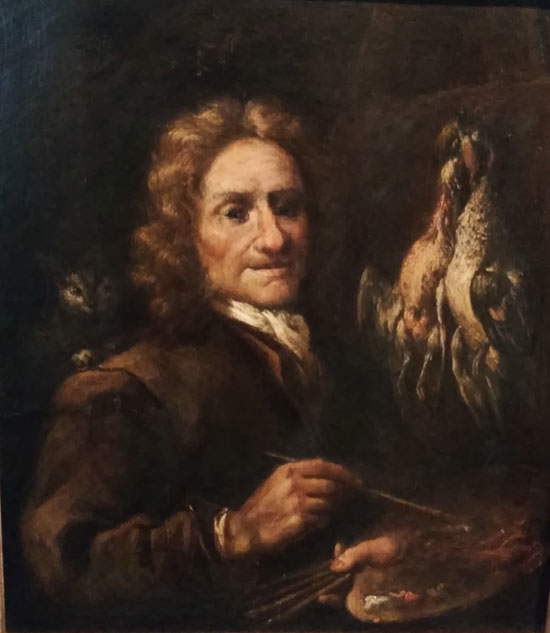 |
| Felice Boselli, Self-Portrait (c. 1720; Parma, National Gallery) |
And in order to better meet the tastes and expectations of the patrons, not infrequently Felice Boselli’s paintings, in addition to cats, are populated by other animals that take on allegorical values: that is, they refer to virtues that were meant to recall the qualities of the person who had commissioned the painting from him, or they constitute invitations to the observer, or even become a sort of augury and good omen. Also at the National Gallery in Parma we find two paintings, probably made in the 1790s, from which this aspect emerges clearly. We do not know the exact provenance of the two canvases, which, given their similar dimensions, could be one pendent of the other: the fact that they depict essentially products of the earth, typical of the Emilian plain, without particularly luxurious elements, and well set in a rustic context, might suggest that they were made for a landowner, a countryman of the painter. Given their subjects, they were most likely paintings for use in dining rooms of country estates.
In the first painting, which depicts a pantry filled with game, in addition to the usual kitten that we see here ravenously biting into a quarter of a pig, we find, on the steps of the pantry, a dove carrying an ear of corn in its beak, and next to her, near a basket, a guinea pig gnawing on some leaves. The dove carrying the ear of wheat is a motif that recurs frequently in the history of art, is a symbol of Christian origin, and is an allegorical reference to peace (the dove) bringing fruitfulness (the wheat), while the guinea pig would be an emblem of fertility: what Felice Boselli paints is, in short, a wish that the lands of his patron, lands of which we see a small glimpse beyond one of the arches of the pantry that served to ventilate the premises, would always be prosperous and productive. And, for that matter, an implicit wish for prosperity can also be read in theabundance of the pantry.
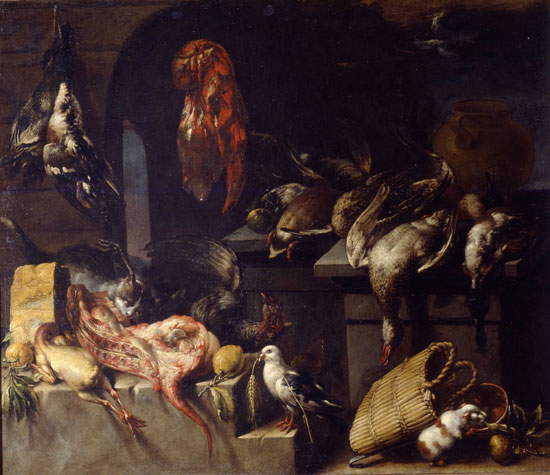 |
| Felice Boselli, Pantry with game, cheese tip, lemons, cat, dove and guinea pig (ca. 1690; Parma, National Gallery) |
The other painting depicts products of the fields (mushrooms, vegetables, poultry, a hare and a calf’s head, oil), and shows as usual the presence of the cat, here depicted nibbling on a calf’s head, but also that of an owl perched on a branch, in a dominant and highly visible position (it is the highest element in the whole composition), looking the observer straight in the eye. Such a presence is to be read in a symbolic key, and might suggest, given the owl’s links with ancient literature, that the work was made for a patron who was not without a certain humanistic education: the small bird is an animal dear to the goddess Minerva, known as “glaucopis” (or “owl-eyed,” as its eyes were believed to resemble those of the bird of prey), and Minerva being the goddess of wisdom, the owl also becomes a metaphor for wisdom. If, therefore, it is placed side by side with food, as in the case of Felice Boselli’s painting, it takes on the invitation to consume food, precisely, wisely, that is, with moderation, without exaggeration: and moderation is a distinguishing trait of the gentleman, who in his manners stands out and rises above coarseness and vulgarity. Also appearing alongside the owl is a green woodpecker depicted in a very natural way: a bird common in the Po Valley, the woodpecker is also a bird linked to mythology, in that it was an animal consecrated to the god Mars, and is a bird of good omen.
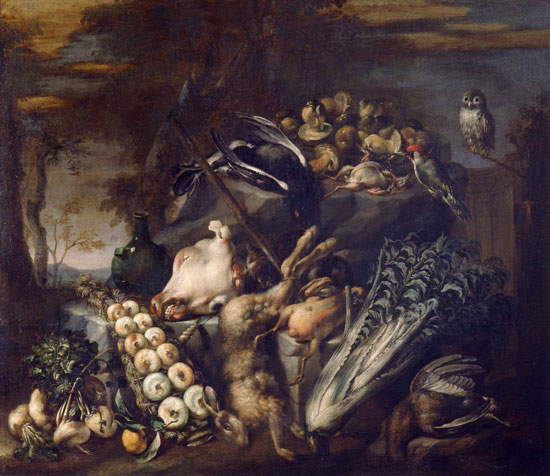 |
| Felice Boselli, Pantry with vegetables, mushrooms, game, calf’s head and owl (ca. 1690; Parma, Galleria Nazionale) |
Felice Boselli was thus a “provincial” painter, very attached to his land, so much so that he introduced into his art that love he had for the landscapes and products of his areas. A country painter who in his paintings was able to offer excerpts, albeit implicit, of the rural life of his Emilia at the turn of the seventeenth and eighteenth centuries, made evident and almost palpable also by the strong density of the colors he used. His is an art that is not particularly innovative or even overly refined, but one that holds cultured meanings and connotations, even in the most markedly material compositions. A simple art, far from elegant, but one that well communicates the strength and industriousness of the farmers who have always worked to reap the fruits of a fertile and bountiful land, which have become the absolute protagonists of the Piacenza painter’s canvases.
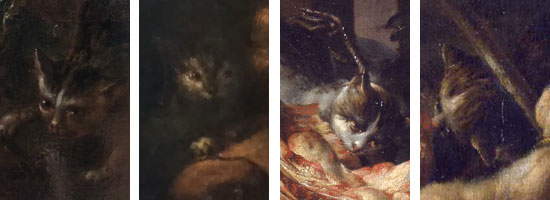 |
| All of Felice Boselli’s cats in the works discussed in the article |
Warning: the translation into English of the original Italian article was created using automatic tools. We undertake to review all articles, but we do not guarantee the total absence of inaccuracies in the translation due to the program. You can find the original by clicking on the ITA button. If you find any mistake,please contact us.





























